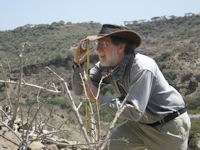Study to link climate and early human evolution

Geologists at the University of Liverpool are excavating a two-million-year-old World Heritage Site in Tanzania to understand how climate variations may have contributed to early human evolution.
Olduvai Gorge is a steep-sided ravine on the edge of the Serengeti Plain, East Africa, and is home to some of the world’s most important fossil hominins. Geologists are investigating the chemical composition of carbonate rocks that lie beneath the surfaces where early human fossils have been uncovered. The data will help an international team of geologists, paleoanthropologists and archaeologists understand how environmental pressures may have influenced the development of human ancestors and their use of the land.
Professor Ian Stanistreet, from the School of Environmental Sciences, said: “Research findings so far suggest that environmental changes, such as very dry conditions to very wet, were more extreme and took place more frequently than previously thought. It is currently unclear how these changes might have contributed to human evolution, but evidence indicates that an ability to cope with hostile and rapidly changing environments may have characterized and shaped the development of the human race.”
The team is investigating elements in the mineral calcium carbonate, which were deposited in the mud and soil in and around a lake between two and 1.7 million years ago. Carbonates formed in the semi-arid environment of the Olduvai Gorge through evaporation and concentration of soil and lake water. The chemical makeup of calcium carbonate mirrors the chemical composition of the water from which it came, allowing scientists to understand what the original soil water was like and what influenced it, such as climate and vegetation growth.
Elisabeth Rushworth explains: “We are looking at deposits of calcium carbonates, from the oldest samples to the youngest, over a period of 300,000 years. Geochemical analyses allow us to build a picture of what the environment was like and the kind of land that our ancestors would have lived and worked on.”
Professor Jim Marshall added: “There are times when the climate was very wet and the soil may show signs of rainwater and at other times there will be traces of water from the lake which was very alkaline. The lake is now extinct, but our ancestors would have depended on the water and vegetation that grew around it. By understanding the chemical signals in the rocks we aim to learn more about the environmental stresses that would have affected our early ancestors.”
Archeological finds in the Olduvai Gorge include stone tools, and skeletal remains of Homo Habilis and Homo Erectus, as well as bones of, now extinct, wild animals.
Provided by University of Liverpool















